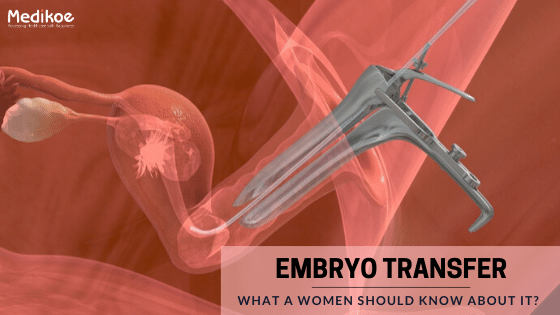Embryo Transfer-what a woman should know about it?
Author : Dr.Monica Sachdeva
Date : 17 Dec 2019
Embryo Transfer - What a women should know about it?
Embryo transfer is the final step of an IVF cycle. It looks simple, but it is a very crucial step. The placement of 1-3 healthy embryos in the uterine cavity 15mm - 20mm just below the fundus through vagina and cervical canal is called embryo transfer.
Any women who are undergoing an IVF cycle is quite apprehensive about the procedure of embryo transfer. Her mind is filled with many questions, and her anxiety level is quite high.
Some commonly asked questions and their befitting replies are as follows:
Q1.Embryo Transfer: is it painful?
Ans. No, it's not. Generally, it is a painless procedure. Sometimes women may feel discomfort as this procedure is done in full bladder. Many a time some NSAIDS given before embryo transfer relieve the anxiety of the women.
Q2.Can I see my embryos before transfer?
Ans. Yes, generally IVF clinics transfer embryos at Day3 stage, i.e. cleavage stage or eight celled stage or on Day 5 stage, i.e. blastocyst stage. The number of embryos transferred, their quality, grading and how many lefts to be stored, all these information are shared by senior embryologist before the transfer. The couple is well informed and is provided pictures of their embryos after transfer too.
Q3.Why do I have some amount of bleeding after transfer?
Ans. Sometimes if there is an infection at the cervical opening, women may experience spotting after transfer. If some resistance was observed in the cervical opening during the assignment, that might also lead to bleeding. But it is not something to be worried about as this does not negatively impact your result.
Q4.When should I avoid embryo transfer being done inside me?
Ans. Avoid transfer or inform your doctor if :
a.excessive bloating or abdominal distension
b.constipation or reduced urine frequency
c.fever or diarrhoea
d.excessive pain abdomen
Q5.Is after embryo transfer complete bed rest mandatory?
Ans. No, that's no the case at all. Only 10 mins of rest in supine position post embryo transfer is sufficient. It is proposed that implantation occurs within 48-72 hours, so many advocates restricted physical activity.IVF is NOT at all an illness which requires bed rest.
Q6.Why am I given injections or vaginal gel after the embryo transfer? Do I really need them?
Ans: Yes, you definitely need supportive medications in the form of gels or injections as after egg retrieval body's progesterone is not sufficient enough to support embryos, we need supplementation to meet their demand.
Q7.If I will pass urine after the transfer, will my embryos wash away?
Ans: No, in fact, after passing urine, the uterocervical angle increases, which will prevent an embryo from being washed away.
Q8.Why are there dietary restrictions if you guys say embryo transfer is a routine procedure?
Ans. Yes, of course, we instruct our patients to have a nutritious, high protein diet and also home-cooked one. This dietary change is to avoid any gastrointestinal infection and upper respiratory tract infection. Spicy food should be avoided as this may lead to aggravating gastritis which already a women faces due to hormonal medications: excessive caffeine intake, alcohol and tobacco to be avoided for obvious reasons.
Q9.Should I stay near the IVF centre post embryo transfer?
Ans.No need at all. You should stay at your home, surrounded by people who are warm caring towards you. You should keep yourself mentally busy and think positive. Light yoga, breathing exercises are beneficial.
Q10.What is the complication of Embryo Transfer?
This procedure has three "E's"(Easy, Effective and Extremely important) associated with it. There is some complication, though rare, need a mention. They are:
- Ovarian hyperstimulation- Ovaries swell up and become painful. They cause fluid retention and decreased urine output. Very rare nowadays.
- Ectopic pregnancy- Rarely embryos are placed a bit higher in the uterus, and less than 1% of cases lead to ectopic pregnancy.

